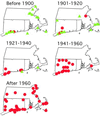Cryptic invasion by a non-native genotype of the common reed, Phragmites australis, into North America
- PMID: 11854535
- PMCID: PMC122384
- DOI: 10.1073/pnas.032477999
Cryptic invasion by a non-native genotype of the common reed, Phragmites australis, into North America
Abstract
Cryptic invasions are a largely unrecognized type of biological invasion that lead to underestimation of the total numbers and impacts of invaders because of the difficulty in detecting them. The distribution and abundance of Phragmites australis in North America has increased dramatically over the past 150 years. This research tests the hypothesis that a non-native strain of Phragmites is responsible for the observed spread. Two noncoding chloroplast DNA regions were sequenced for samples collected worldwide, throughout the range of Phragmites. Modern North American populations were compared with historical ones from herbarium collections. Results indicate that an introduction has occurred, and the introduced type has displaced native types as well as expanded to regions previously not known to have Phragmites. Native types apparently have disappeared from New England and, while still present, may be threatened in other parts of North America.
Figures



References
-
- Mack R N, Simberloff D, Lonsdale W M, Evans H, Clout M, Bazzaz F A. Ecol Appl. 2000;10:689–710.
-
- Pimentel D, Lach L, Zuniga R, Morrison D. BioScience. 2000;50:53–65.
-
- Carlton J T. Ecology. 1996;77:1653–1655.
-
- Geller J B, Walton E D, Gorsholz E D, Ruiz G M. Mol Ecol. 1997;6:901–906. - PubMed
-
- Bastrop R, Jurss K, Strumbauer C. Mol Biol Evol. 1998;15:97–103. - PubMed
Publication types
MeSH terms
Associated data
- Actions
- Actions
- Actions
- Actions
- Actions
- Actions
- Actions
- Actions
- Actions
- Actions
- Actions
- Actions
- Actions
- Actions
- Actions
- Actions
- Actions
- Actions
- Actions
- Actions
- Actions
- Actions
- Actions
- Actions
- Actions
- Actions
- Actions
- Actions
- Actions
- Actions
LinkOut - more resources
Full Text Sources
Miscellaneous

